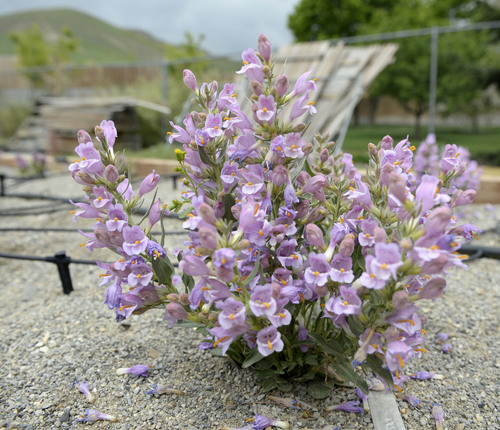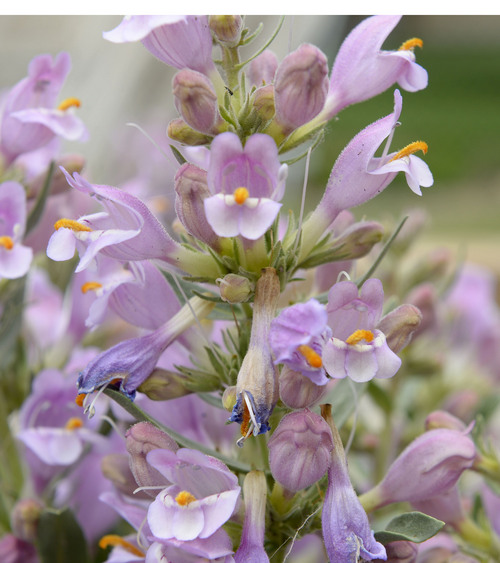This is an archived article that was published on sltrib.com in 2014, and information in the article may be outdated. It is provided only for personal research purposes and may not be reprinted.
If you want to see some of Utah's most colorful species of desert wildflowers, you have to look in exactly the same places as those hoping to mine oil shale — near black ledges where kerogen-bearing rock outcrops in the Uinta Basin.
Because of this overlap of habitat and valuable mineral deposits, Graham's and White River beardtongue have long been considered for protection under the Endangered Species Act.
But on Tuesday, the U.S. Fish and Wildlife Service announced it was withdrawing its petition to list these two rare native plants as threatened after concluding a new 15-year conservation agreement will ensure the survival of these flowers, also known as penstemon.
Environmental activists, however, contend Fish and Wildlife is flouting the law and its own guidelines and has caved to political pressures.
"The agency may not base a listing decision on anticipated future conservation actions, which is exactly what they are doing here," said Lori Ann Burd, endangered species campaign director for the Center for Biological Diversity. "These are species that have experienced declines for decades. To think you can recover these slow-growing fragile plants in 15 years, no one will say that's possible."
The agreement Fish and Wildlife reached two weeks ago with Uintah County, Bureau of Land Management and various state agencies designates some 44,000 acres where surface-disturbing activities will be severely limited.
While critics say the plan doesn't protect enough land to safeguard the flowers' future and is short on guarantees, Fish and Wildlife has determined the agreement is adequate because of the certainty that its conservation measures will be implemented and effective.
"It's important for us to find common ground and work collaboratively when addressing the needs of imperiled species," said Noreen Walsh, Fish and Wildlife's Mountain-Prairie Region director, in a press statement. "We are confident that the conservation agreement will assist the Service and its conservation partners in protecting these rare beardtongues in both Utah and Colorado."
The 44,000 acres is substantially less than the 84,000 acres Fish and Wildlife proposed for critical habitat under a listing, Burd noted.
Almost 87 percent of the land to be conserved is federal, and the rest is private and state trust lands. The agreement protects 64 percent and 76 percent of the known populations of Graham's and White River beardtongues, respectively, according to Fish and Wildlife.
Conservation areas for Graham's can sustain no more than 5 percent surface disturbance. For White River, the limit is only 2.5 percent. In addition, disturbance cannot occur within 300 feet of a plant.
"We don't expect surface mines in areas with that level of disturbance cap," said Tova Spector, a botanist in Fish and Wildlife's Utah office, although these areas could remain open to conventional drilling.
Grazing may continue, but monitoring will take place on federal allotments and stocking levels could be reduced should beardtongue struggle.
"They are part of a large community of oil-shale endemic plants and pollinators that rely on these flowers," Spector said.
Meanwhile, recent surveys suggest beardtongue is not as rare as was believed back in 2006, the last time Fish and Wildlife considered a listing.
For example, the known population of Graham's has increased six-fold, to more than 40,000 individuals, over the past seven years, according to the service's posting Wednesday on the Federal Register. This is not because the plant is rebounding or its range is expanding, but because surveys are more complete and routinely document new populations.
But more than 90 percent of the beardtongues' range could be erased if the basin's oil shale deposits are fully developed.
Transplanting and habitat restoration has never worked for beardtongue, so the only sure way of preserving the species is shielding land from development. Environmentalists say the best guarantee of success would be federal protection that goes with an Endangered Species Act listing.
"These wildflowers have waited decades for protection, and now they just might go extinct because of a bad decision by the Obama administration," said Tony Frates with the Utah Native Plant Society.







